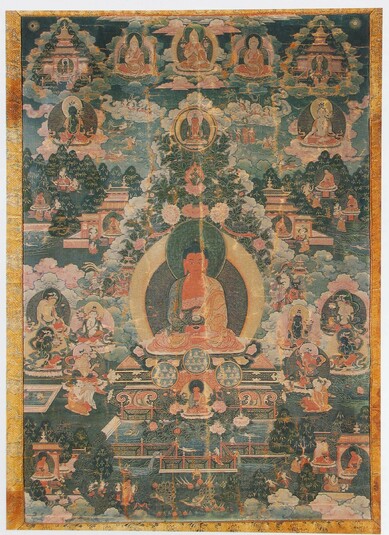
Item: Amitabha Buddha - Pureland (Sukhavati)
| Origin Location | China |
|---|---|
| Date Range | 1800 - 1899 |
| Lineages | Gelug and Buddhist |
| Material | Ground Mineral Pigment on Cotton |
| Collection | Publication: A Tale of Thangkas |
Classification: Deity
Appearance: Buddha
Gender: Male
Amitabha, Buddha (Tibetan: o pag me, sang gye. English: the Enlightened One of Immeasurable Light) residing in the pureland of Sukhavati with the Eight Great Bodhisattvas seated at the sides.
Amitabha depicted in the Sukhavati Heaven is a common image in Himalayan and Tibetan art. It is an iconic symbol and subject representing Mahayana Buddhism. The basic figures, characters, and scenes are common for most representations in all of the different traditions despite having several composition and artistic styles and types.
There are three basic composition types. The first is the square, or more properly the rectangular, style. In this format Amitabha is presented as the largest figure in the center of the composition seated in front of a large tree and sometimes a palace. A bodhisattva stands at the right and left side. These two attendant figures belong to the group of the Eight Great Bodhisattvas. The remaining bodhisattvas are seated at the right and left. Shravakas and monastic figures are often seated in front. The remaining space of the composition is filled with buddhas, bodhisattvas, gods and goddesses, offering goddesses, and meritorious beings taking birth on a lotus blossom at the bottom of the painting.
Jeff Watt 11-2012
Buddhist Deity: Amitabha Buddha Main Page (阿弥陀佛 / འོད་དཔག་མེད།)
Buddhist Deity: Amitabha Buddha (Sukhavati, Square Format)
Publication: A Tale of Thangkas

